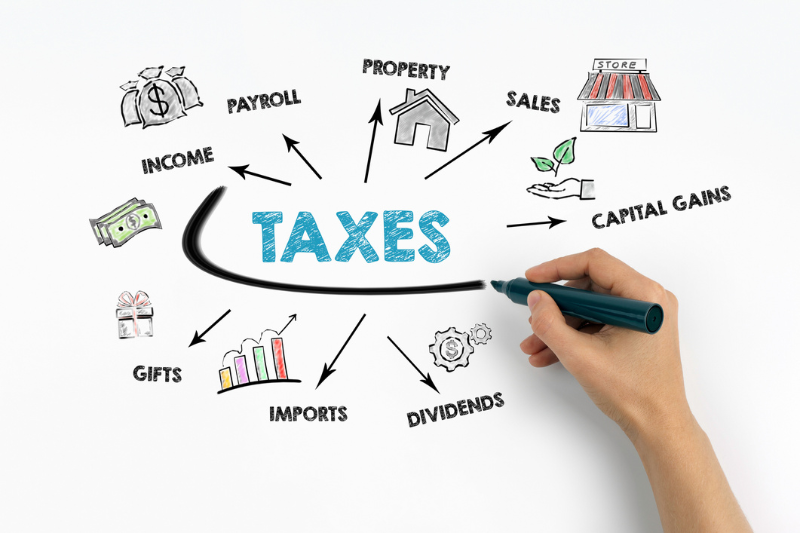
Types of Taxes and Their Structures
Taxes come in many different varieties, with each designed for governmental needs and responsibilities. Understanding different types of taxes allows us to comprehend how governments generate revenue and manage their financial responsibilities.
Source: Types of Taxes
Income taxes are one of the most well known forms of government revenue. These come from individuals through personal income tax and businesses through corporate income tax. Personal income tax is calculated based on an individual’s total annual earnings (wages, salaries, and investments). Tax brackets divide income levels into categories, helping organize the amount tax. Marginal tax rates apply to each income in the bracket - higher earnings have progressively higher rates. For example, a person earning $60,000 may pay 10% on the first $10,000 and progressively higher percentages on subsequent amounts. Brackets help reflect the equity aspect of taxation, since those who earn more contribute more. Corporate income taxes are similar to personal income taxes; however, corporate taxes are based on a company’s profits rather than individual earnings. Corporate tax is calculated by subtracting allowable expenses (operational costs and employee salaries) from their gross revenue. Income taxes are fundamental in funding national programs such as defense, healthcare, and infrastructure.
Consumption taxes are taxes put on goods and services when purchased; these are integral to the daily economic transactions. Some of the most well known consumption taxes are sales taxes, value-added taxes (VAT), and excise taxes. Sales taxes are calculated as a percentage of the price of the product and added to its cost. For example, a $100 dollar game might have a 7% sales tax, so the customer would have to pay $107 (7% of $100 is $7). VAT is a bit more complex - it is applied at each stage of production and distribution, showing an added value at each step. VAT can be paid on raw materials by a manufacturer, and a retailer can pay VAT on the finished product. VAT systems are often used in countries outside the USA. Excise taxes are for certain goods and services, and are put in place to regulate consumption. Some products that have excise taxes are alcohol, tobacco, and gasoline. Another name for these taxes are “sin taxes” - they are often in place to discourage behaviors harmful to society. Overall, consumption taxes can fund public projects while influencing consumer choices.
Property taxes are placed on tangible assets such as real estate and vehicles. Homeowners pay taxes based on the value of their property, and these taxes are used by the local government to fund services such as schools, police departments, and public parks. For example, a property with a value of $300,000 can be subject to a 1% tax rate, meaning the tax would be $3,000 annually. Another example of property taxation is vehicle taxes, calculated based on a car’s age, value, and emissions. These taxes are used to fund transportation infrastructure such as roads and bridges. Property taxes are one of the biggest forms of taxes to ensure services are accessible and functional.
Payroll taxes are taxes shared by employers and employees. These fund programs such as Social Security, which provides income for retired and disabled people. Additionally, it funds Medicare, which offers healthcare for seniors. In a payroll tax, a portion of an employer's and employee's paycheck is deducted for these organizations. For example, an employee can contribute 6.2% of their earnings to social security, and an employer would pay an extra 6.2% as well. Payroll taxes help maintain social safety nets and ensure workers can access support systems throughout their lives. However, due to the same rate being applied in payroll taxes, these are seen as less equitable than income taxes.
In addition to the major categories of taxes discussed, there are other types of taxes with unique purposes. Capital gains taxes are placed on the profit made from selling assets such as stocks and real estate. For example, an individual who sells a $1000 stock for $1500 would pay taxes on the $500 profit. Inheritance taxes are placed on the transfer of wealth once someone dies, and tariffs are taxes on imported goods, designed to regulate trade and protect domestic industries.
Tax structures differ at the federal, state, and local levels of government. Federal taxes fund national programs, while state and local taxes address their regional needs such as education and public transportation. Each type helps an individual witness their contribution to these improvements.
The diverse types of taxes and structures show the complexity of today’s systems. Income, consumption, property, payroll, and other taxes each have a purpose, from funding to changing economic behaviors. By understanding these taxes, individuals can improve their financial choices. As we delve deeper into taxation, the nuances of these structures will further illustrate their impact on daily life and society.
